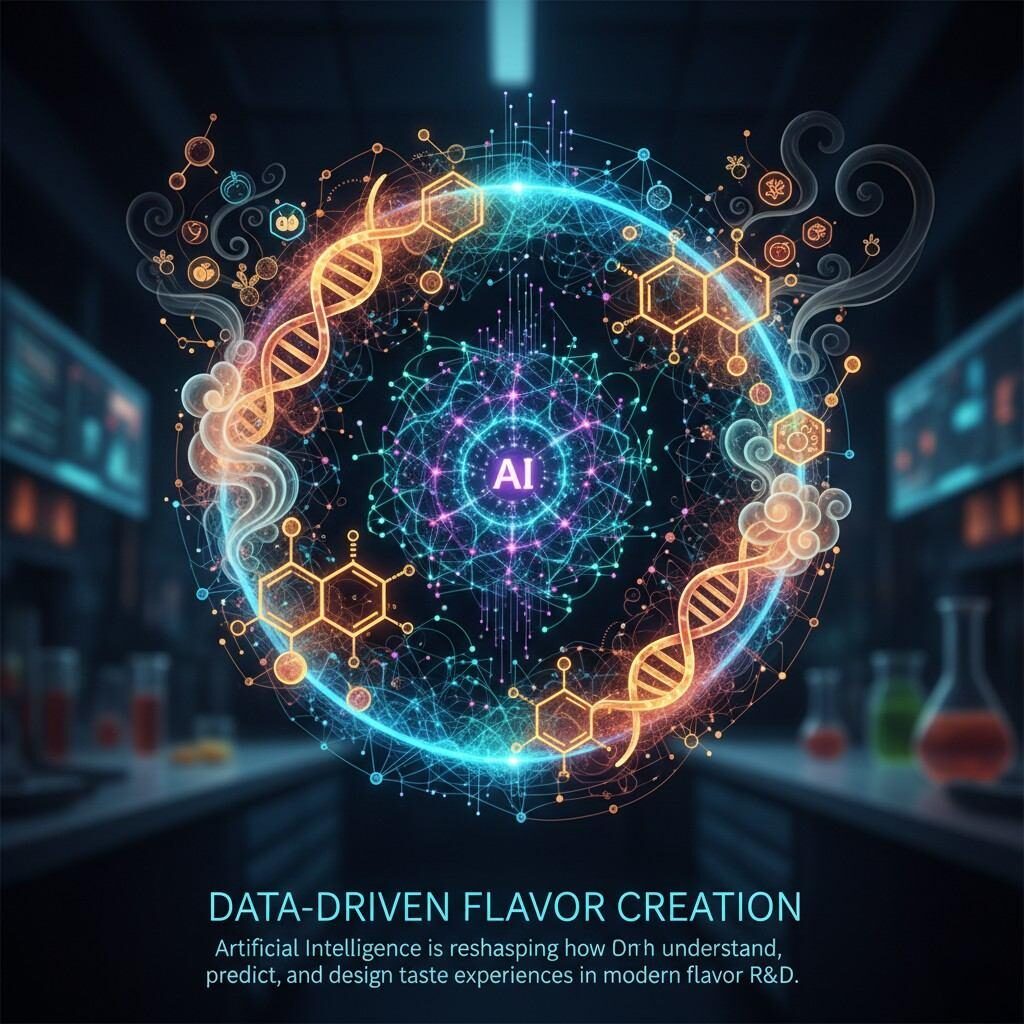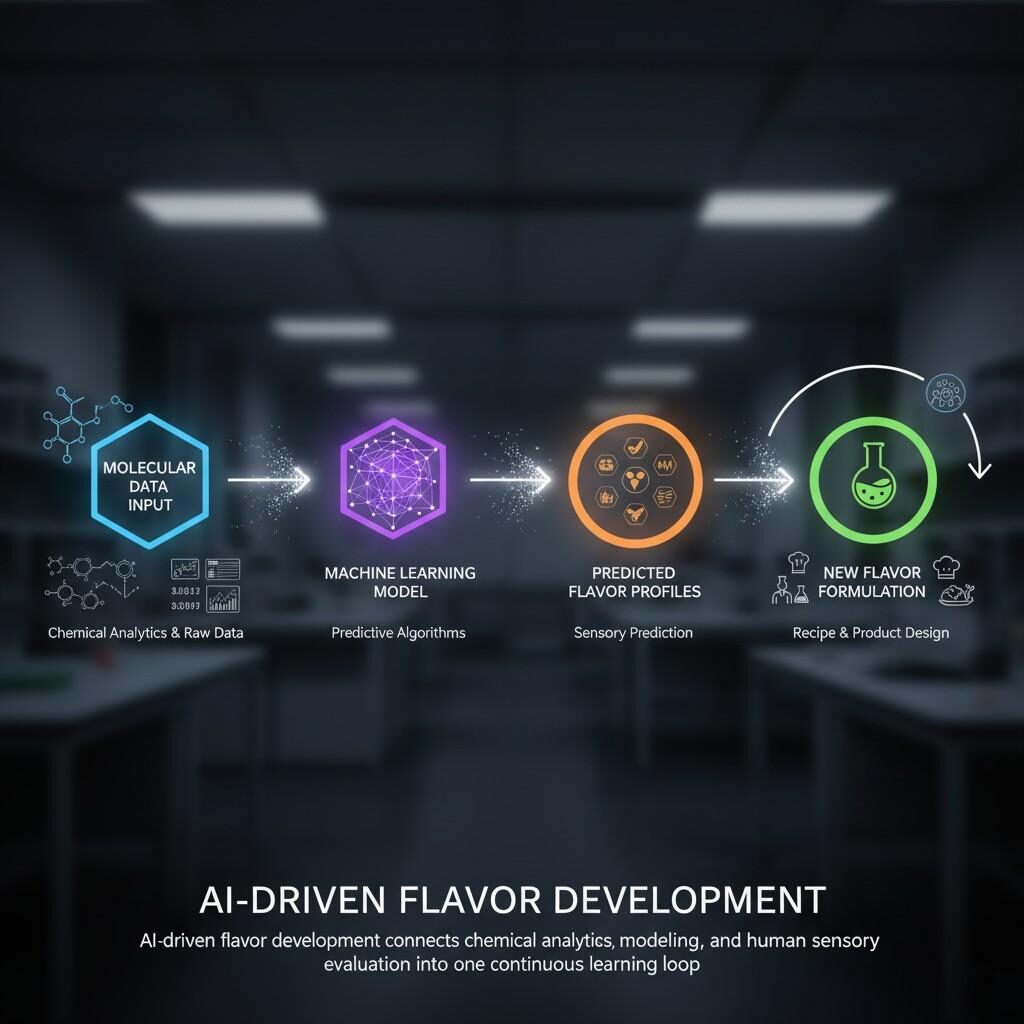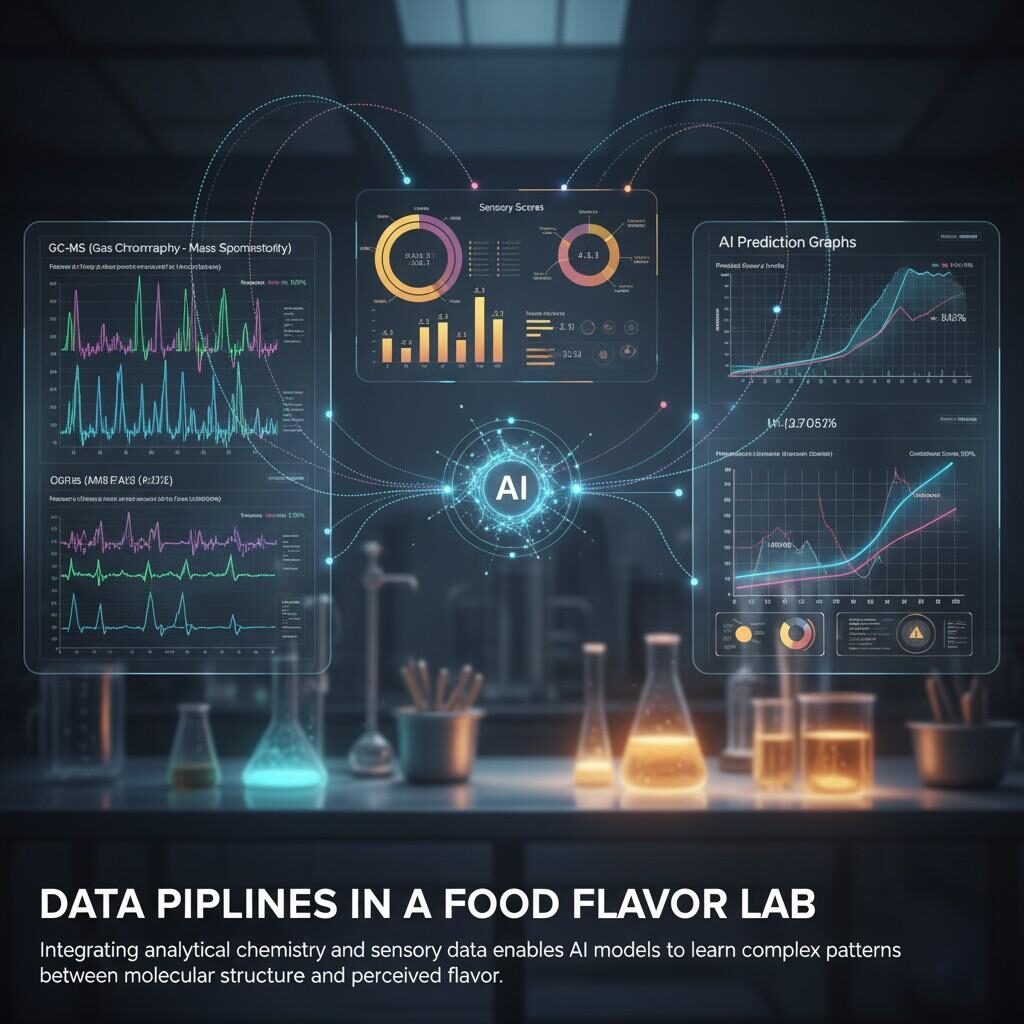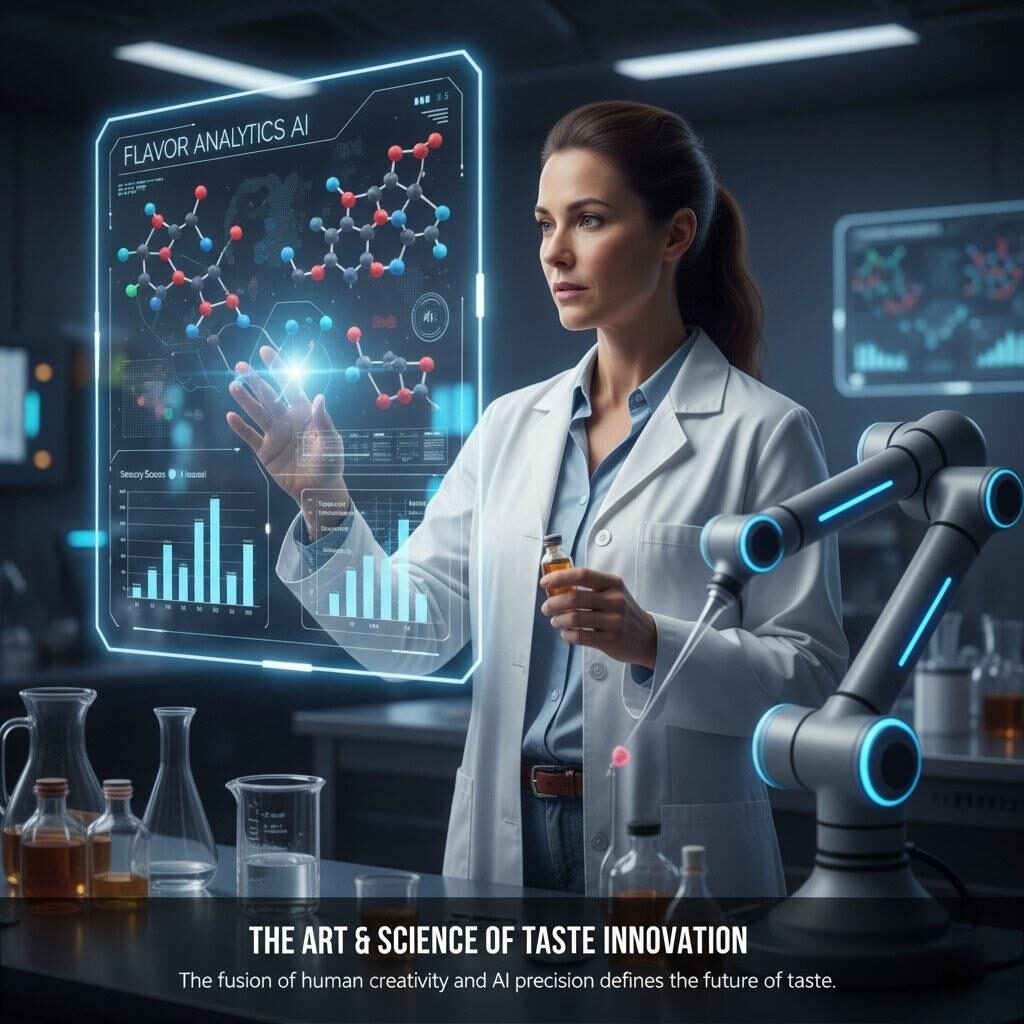Author: R&D Team, CUIGUAI Flavoring
Published by: Guangdong Unique Flavor Co., Ltd.
Last Updated: Oct 15, 2025
In the rapidly evolving landscape of food and beverage science, artificial intelligence (AI) is no longer a futuristic dream — it’s becoming a key driver in flavor innovation. As manufacturers seek to accelerate development cycles, reduce cost, and respond more precisely to shifting consumer preferences, AI-enabled approaches are emerging as a high-leverage tool. This article explores how AI is reshaping flavor development: its underlying technologies, applications, opportunities, challenges, and strategic considerations.
Below is a proposed structure to guide your reading:

AI in Flavor Creation
The flavor industry faces mounting pressures: increasingly discerning consumers, clean-label demands, cost volatility in raw materials, the need for speed to market, and deeper personalization. Traditional flavor R&D — relying heavily on trial-and-error, empirical sensory panels, and incremental tweaks — is often too slow and resource-intensive to keep pace.
AI offers a compelling way to augment human expertise by processing massive datasets, predicting flavor interactions, and generating candidate formulations that would be too time-consuming to explore by hand. Indeed, recent scholarly reviews describe AI as transformative for gustation and olfaction research, enabling deeper insight into how humans perceive taste and smell.
Market forecasts echo this optimism: the “AI in Food & Beverages” market is projected to grow from about USD 13.39 billion in 2025 to USD 67.73 billion by 2030, at a compound annual growth rate (CAGR) of ~38.3 % . Within flavor science, AI is increasingly recognized in industry thought leadership as a key trend alongside precision fermentation, natural sweeteners, and personalized nutrition.
Moreover, major players in the flavor and consumer goods space are already deploying AI in formulation pipelines. For example, DSM-Firmenich announced its first AI-created flavor — a lightly grilled beef taste for plant-based meat analogs — developed by analyzing ingredient usage and formulary patterns.
Thus, AI is not purely experimental; it is being integrated into real-world flavor development workflows.
This document is written for R&D leaders, flavorists, process engineers, and strategic decision-makers in flavor / food & beverage manufacturing. Its goal is to offer an authoritative technical overview of AI in flavor development — going beyond marketing hype to practical architectures, case studies, and guidance for adoption.
By the end, readers should have clarity on:
Let’s begin with the fundamentals of flavor science and data.
Before diving into AI, it’s essential to ground ourselves in how flavors are understood scientifically, how they are measured, and how those data serve as inputs to intelligent algorithms.
“Flavor” in food science is a composite percept: a fusion of taste (gustation), aroma (olfaction), and trigeminal sensations (texture, mouthfeel, chemesthetic stimuli). Taste receptors (sweet, sour, salty, bitter, umami) detect soluble compounds via gustatory cells; olfactory receptors detect volatile compounds via retronasal and orthonasal routes. The brain integrates these signals, along with contextual cues (temperature, texture, memory).
Flavorists often characterize a flavor profile in terms of multiple axes (e.g. fruity, green, floral, roasted, fatty) and map molecular compounds to those sensory descriptors. In practice, flavor development is an optimization across chemical space and sensory mapping.
To feed AI models, you need high-quality data. Key analytical approaches include:
The combination of chemical and sensory data creates a mapping from ingredients & structure to perception, which is the foundation for AI modeling.
Raw measurement data must be cleaned, normalized, and engineered into suitable features before feeding into AI. Some key steps:
A well-engineered data representation is often more critical than model choice in flavor AI applications.
In flavor- AI, common modeling objectives include:
Projects often combine several objectives (e.g. predict sensory scores and then generate candidate mixtures above a threshold).
Indeed, in the EU-funded VIRTUOUS project, machine learning models are used to predict taste profiles (e.g. bitterness, sweetness) from chemical structure and physicochemical features. Likewise, sensory and flavor modeling work is discussed in the literature on advances in AI for gustation and olfaction.
With this foundation, we turn to the AI architectures and methods powering flavor innovation.
This section overviews state-of-the-art AI/ML techniques relevant to flavor development, and their strengths/tradeoffs.
These are relatively well-understood methods that remain useful as building blocks:
These are useful when datasets are moderate in size and interpretability is important.
Deep neural networks (DNNs) provide more expressive power, especially when large data are available.
Flavor AI often benefits from hybrid approaches:
Beyond prediction, AI can generate new candidate molecules or mixtures:
Note that multiple papers now publish AI systems for de novo taste peptide design; e.g. TastePepAI is an AI framework for designing taste peptides (sweet, umami, salt) with safety filtering.
To close the loop between virtual models and physical reality, many labs integrate robotics, sensing, and automated experimentation. For example, a system might:
One such example is a robotic system optimizing powdered beverages using computer vision and Bayesian optimization. arXiv
This infrastructure enables rapid iterations and reduces manual effort, creating a “self-driving R&D lab.”
With the method toolkit covered, we now look at concrete applications of AI in flavor development.
Here are the major use cases where AI is adding value in flavor R&D.

AI Flavor R&D Workflow
One of the earliest and most intuitive use cases: use AI models (e.g. graph embeddings, co-occurrence modeling) to suggest novel ingredient or compound pairings.
A notable example is FlavorGraph, developed by Sony AI and Korea University, which links food ingredients and molecular compounds via a large-scale graph network. It can suggest new pairings or substitutes based on chemical relationships and recipe co-occurrences.
By training on molecular graphs and recipe metadata, FlavorGraph can propose pairings that humans might not foresee, accelerating ideation of novel flavor combinations.
Using AI models, you can predict how a given compound or blend will score along sensory axes (sweetness, bitterness, etc.), or hedonic liking (consumer preference). This allows early filtering of low-promise candidates before bench testing.
In the EU’s VIRTUOUS project, models predict taste perception (sweet, bitter, umami) from molecular features to estimate flavor potential. In parallel, broader reviews show how AI is improving organoleptic prediction by integrating sensor data and metabolomics.
Once base candidate compounds are identified, AI can optimize blending ratios, taking into account constraints (cost, regulatory, allergen, stability). Common approaches:
These methods can find non-obvious optimal ratios far faster than manual grid searches.
In real-world manufacturing, ingredients change — due to cost, supply chain, regulatory, or consumer demand (e.g. removing artificial components). AI can suggest substitutions or tweaks that preserve the target sensory profile within constraints.
For example, AI models can search in ingredient space for natural alternatives matching the same molecular profiles or sensory embeddings. These suggestions can then be validated experimentally. Several industry blogs highlight AI as a tool for clean-label reformulation.
AI can ingest large datasets of consumer reviews, demographic data, regional trends, social media mentions, and sensory panel data to predict which flavors will resonate with specific segments. Some possible tasks:
For instance, one beverage manufacturer used Gastrograph AI to model flavor preferences of female millennials in Japan, mapping “white space” in flavor space and proposing new flavor directions (e.g. a pine-based beverage) that were not in the original brief.
AI models can work with “electronic nose / tongue / sensor arrays” to detect chemical signatures and map them to sensory profiles. In effect, these systems emulate human tasting in the loop.
A recent review describes how AI is increasingly integrated with sensor data to simulate flavor profiles and augment human sensory panels.
Beyond purely chemical or sensory metrics, emerging use cases involve tying flavor development to emotions, narratives, or cultural cues. For instance, an AI system was used to co-create “Romance Bread,” a flavored bread series based on TV program emotional cues, converting text (lyrics, dialogues) into ingredient suggestions.
Another consumer-facing AI approach in Japan used emotional scoring (e.g. love, heartbreak) to map flavor experiences and generate AI-inspired bakery products.
These approaches hint at a future where flavors carry emotional narratives, not just sensory descriptors.
Beyond innovation, AI plays a role in monitoring flavor consistency. With sensor / spectrometry input, models can detect batch-to-batch drift, deviations, or contamination by comparing measured signatures to expected profiles.
AI-based anomaly detection helps minimize waste and quality failures preemptively.
Here are real-world deployments that illustrate how AI is being used in flavor / food & beverage R&D.
As mentioned, DSM-Firmenich announced the first flavor formulated by an AI-assisted process: a natural, lightly grilled beef flavor for plant-based meat analogs. The AI system analyzed existing flavor formula usage, ingredient co-occurrence, and compound patterns to propose candidate blends, which were then refined.
This milestone demonstrates that AI-generated flavors can move from ideation to viable commercial candidates.
FlavorGraph uses a large-scale graph embedding approach to map molecular compounds and food ingredients, learning relationships and latent proximities. In practice, it suggests novel pairings that outperform baseline methods for ingredient matching.
This approach is valuable in ideation and exploration of new flavor landscapes.
A drinks company used Gastrograph AI to analyze competitive flavor space in Japan and uncover new flavor opportunities targeted at millennial women. The AI model explored combinations and predicted market preference distributions, enabling faster and more confident flavor concept selection.
Mondelez International, the maker of Oreo and other snacks, uses AI (in collaboration with Fourkind / Thoughtworks) to accelerate recipe development. The AI tool helps optimize snacks by flavor, cost, nutritional profile, and environmental impact. Because of this, new product variants and tweaks can reach pilot testing 4–5x faster than traditional methods.
Researchers at KU Leuven analyzed 250 Belgian beers, combining chemical composition (hundreds of odorant molecules) and consumer review data to build machine learning models predicting taste and preference. They identified key compounds (e.g. lactic acid, glycerol) that influence flavor perception.
This kind of reverse modeling — mapping chemistry to sensory impression — can inform targeted flavor tweaks.
In academic research, a robotic system optimized powdered beverage parameters (e.g. mixing ratio, temperature) using computer vision feedback and Bayesian optimization. This closed-loop approach significantly accelerated parameter search and demonstrated the synergy of robotics + AI in flavor development.
How can a flavor company practically adopt AI into its R&D pipeline? Below is a phased roadmap, best practices, and strategic considerations.

Flavor Lab Data Pipelines
With care and discipline, flavor companies can transform their R&D pipeline from slow and siloed to agile and data-driven.
While AI holds much promise, it is not a silver bullet. Below are key challenges and ways to mitigate them.
Mitigations: rigorous data cleaning, cross-lab calibration, replication, augmentation, uncertainty modeling.
Models may perform well on interpolation but struggle when venturing outside the domain (e.g. novel chemical space). Overfitting is a real risk.
Mitigation: regularization, validation on held-out “novel” compounds, adversarial robustness, domain adaptation techniques.
Black-box AI may propose candidate blends that challenge conventional wisdom or seeming plausibility. Without transparency, flavorists may reject them.
Mitigation: include explainable components, attribution, human-in-the-loop review, domain guardrails, safety filters.
R&D teams may resist adoption due to cultural inertia, fear of obsolescence, or lack of AI literacy.
Mitigation: offer training, pilot success stories, involve domain staff early, emphasize augmentation, not replacement.
Mitigation: embed toxicity filters, safety review, logging & versioning, clear IP agreements, regulatory oversight.
Deploying AI (hardware, data infrastructure, software development) incurs cost.
Mitigation: start small, use cloud services, partner with AI platform providers, scale incrementally.
The flavor space shifts as raw materials, suppliers, regulations, and consumer trends evolve. AI models degrade over time.
Mitigation: continuous monitoring, retraining, scheduled evaluation, data pipeline refresh.
By acknowledging and proactively addressing these challenges, companies can avoid pitfalls and sustain long-term success.
What lies ahead? Below are emerging frontiers where AI and flavor science intersect.
Recent work describes an artificial tongue based on graphene oxide membranes that can sense and “learn” taste signatures in liquid, acting as a sensory front-end for AI systems. Live Science As sensor tech becomes more biomimetic, AI can better interface with real-time chemical detection.
Future models may integrate visuals (e.g. color and texture), sound (e.g. crunch), and contextual cues (temperature, packaging) into flavor prediction. This can create holistic sensory experience modeling.
One can envision flavors tailored to individual genetics, gut microbiomes, or lifestyle profiles — with AI customizing flavor formulas per consumer. As personalized nutrition converges with flavor, new markets open.
R&D labs may become more automated: AI proposes, robots run experiments, sensors feed back data, and models refine themselves in closed loops. Such autonomous systems accelerate innovation cycles.
AI may be used to source “waste-to-flavor” ingredients (byproducts, upcycled materials) and optimize flavor yield from low-cost or sustainable raw materials, aligning with green standards. AI-driven substitution and resource optimization will be key.
Flavor companies may share anonymized embeddings or models (without revealing proprietary data) via federated learning, benefiting from collective chemical / sensory datasets while preserving IP.
Models trained on fragrance, flavor, or even pharmaceutical odorants might transfer knowledge, enabling cross-domain innovation in taste, odor, and bioactive compounds.
These trends suggest that AI-driven flavor development will not just augment R&D but transform business models and product experience.

Flavorist & AI Collaboration
Artificial intelligence is reshaping flavor development from a cottage-industry of trial-and-error into a data-driven, agile, and high-leverage domain of innovation. By integrating chemical, sensory, and consumer data, AI empowers flavorists to explore vast formulation spaces more efficiently, propose novel combinations, perform substitution under constraints, and align flavor innovation with personalized consumer insights.
Yet success requires more than deploying a model: it demands strategic alignment, quality data infrastructure, domain oversight, interpretability, and iterative refinement. Companies that thoughtfully incorporate AI into their R&D pipelines will gain competitive advantage: faster ideation, higher hit rates, lower waste, and deeper consumer resonance.
We invite you to engage with us in the next frontier of taste innovation. Request a free technical exchange or sample flavor concept and explore how AI-assisted flavor development can transform your product pipeline.
📩 [info@cuiguai.com]
📞 [+86 189 2926 7983]
🌐 Explore more at 【www.cuiguai.cn】
Copyright © 2025 Guangdong Unique Flavor Co., Ltd. All Rights Reserved.